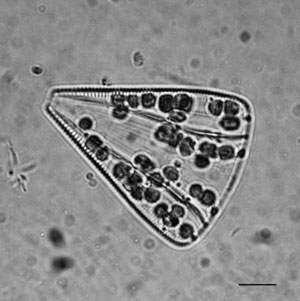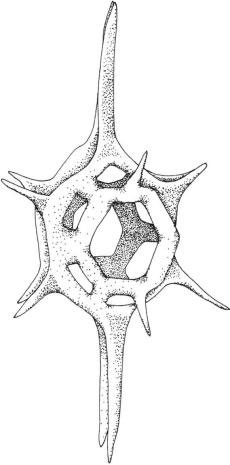Rhodophyta
The red algae mostly consist of seaweeds but also include the genera of free-living unicellular
microalgae. The class Bangiophyceae (Figure 1.24) retains morphological characters that are
found in the ancestral pool of red algae and range from unicells to multicellular filaments or
sheet-like thalli. The Floridophyceae (Figure 1.29) includes morphologically complex red algae
and are widely considered to be a derived, monophyletic group. Rhodophyta inhabit prevalently
marine ecosystems but they are also present in freshwater and terrestrial environment. The lack
of any flagellate stages and the presence of accessory phycobiliproteins organized in phycobilisomes
(shared with Cyanobacteria, Cryptophyta, and Glaucophyta) are unique features of this division;
chlorophyll a is the only chlorophyll. Chloroplasts are enclosed by a double unit membrane;
thylakoids do not stack at all, but lie equidistant and singly within the chloroplast. One thylakoid is
present around the periphery of the chloroplast, running parallel to the chloroplast internal membrane.

FIGURE 1.24 Life cycle of Porphyra sp.: 1, male gametophyte; 10, female gametophyte; 2, sperm; 2', egg; 3, fertilization and zygote; 4, spores; 5, sporophyte; 6, male spore; 6', female spores; 7, young male gametophyte; young female gametophyte. R!, meiosis.

FIGURE 1.29 Frond of Rhodophyllis acanthocarpa. (Bar: 5 cm.)
The chloroplastic DNA is organized in blebs scattered throughout the whole chloroplast.
The most important storage product is floridean starch, an a-1,4-glucan polysaccharide. Grains
of this starch are located only in the cytoplasm, unlike the starch grains produced in the Chlorophyta,
which lie inside the chloroplasts. Most rhodophytes live photoautotrophically. In the great
majority of red algae, cytokinesis is incomplete. Daughter cells are separated by the pit connection,
a proteinaceous plug that fills the junction between cells; this connection successively becomes a
plug. Species in which sexual reproduction is known generally have an isomorphic or heteromorphic
diplohaplontic life cycle; haplontic life cycle is considered an exception.
HETEROKONTOPHYTA
One of the defining features of the members of this division is that when two flagella are present,
they are different. Flagellate cells are termed heterokont, that is, they possess a long mastigonemate
flagellum, which is directed forward during swimming, and a short smooth one that points
backwards along the cell. Chrysophyceae contain single-celled individuals as well as
quite colonial forms. Xanthophyceae can be unicellular (coccoids or not) filamentous, but the most
distinctive species are siphonous. All known species of Eustigmatophyceae are
green coccoid unicells either single, in pairs or in colonies. Bacillariophyceae are
a group of unicellular brown pigmented cells that are encased by a unique type of silica wall, composed
of two overlapping frustules that fit together like a box and lid (Figure 1.30 and
Figure 1.31). Raphidophyceae are unicellular wall-less heterokonts (Figure 1.32). Dictyochophyceae,
known as silicoflagellates, are unicells that bear a single flagellum with mastigonemes (Figure 1.33). Phaeophyceae are multicellular, from branched filaments to massive and complex
kelp (Figure 1.34).

FIGURE 1.30 Marine diatom. (Bar: 10 µm.)

FIGURE 1.31 Freshwater diatom. (Bar: 20 µm.)

FIGURE 1.32 Unicell of Heterosigma akashiwo.

FIGURE 1.33 The silicoflagellate Distephanus speculum.

FIGURE 1.34 Frond of Bellotia eriophorum. (Bar: 5 cm.)
Other groups of algae have been described as belonging to this division, such
as Pelagophyceans and Sarcinochrysidaleans sensu Graham and Wilkox (2000) and Parmales
sensu Van den Hoek et al. (1995). Heterokontophyta are mostly marine; but they can be found
also in freshwater and terrestrial habitats. They show a preponderance of carotenoids over chlorophylls
that result in all groups having golden rather than grass green hue typical of other major
algal divisions. The members of this division possess chlorophylls a, c1, c2, and c3 with the exception
of the Eustigmatophyceae that have only chlorophyll a. The principal accessory pigments are
β-carotene, fucoxanthin, and vaucheriaxanthin. The thylakoids are grouped into stacks of three,
called lamellae. One lamella usually runs along the whole periphery of the chloroplast, which
is termed girdle lamella, absent only in the Eustigmatophyceae. The chloroplasts are enclosed
in their own double membrane and also by a fold of the endoplasmic reticulum. The chloroplastic
DNA is usually arranged in a ring-shaped nucleoid. Dictyochophyceae species possess several
nucleoids scattered inside the chloroplast. The main reserve polysaccharide is chrysolaminarin,
a b-1,3-glucan, located inside the cytoplasm in special vacuoles. The eyespot consists of a
layer of globules, enclosed within the chloroplast,
and together with the photoreceptor, located
in the smooth flagellum, forms the photoreceptive apparatus. The members of this division can
grow photoautotrophically but can also combine different nutritional strategies such as heterotrophy.
The Heterokontophyta species that reproduce sexually have a haplontic (Chrysophyceae),
diplontic (Bacillariophyceae) or diplohaplontic (Phaeophyceae) life cycle.











